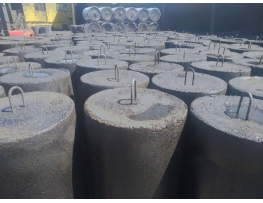Cylinder electrode paste is a crucial component in the manufacturing process of carbon electrodes used in the production of aluminum and other metals. It plays a vital role in ensuring the efficiency and effectiveness of the electrolytic process.
Composition:
Cylinder electrode paste is primarily composed of a carefully formulated blend of calcined petroleum coke, coal tar pitch, and various additives. Calcined petroleum coke, derived from petroleum coke through a high-temperature carbonization process, is the primary carbonaceous material used in the paste. It provides the necessary carbon content and conductivity required for the electrodes.
Coal tar pitch, a byproduct of the distillation of coal tar, acts as the binder in the paste. It holds the coke particles together, providing mechanical strength to the electrode during the manufacturing process and in-service conditions. The composition of the paste may also include additional components such as anthracene oil, synthetic graphite, and various proprietary additives to enhance specific properties.
Properties:
Cylinder electrode paste exhibits several key properties that make it suitable for its intended applications. These properties include:
Electrical Conductivity: The high carbon content of the paste, derived from calcined petroleum coke, provides excellent electrical conductivity. This property ensures efficient transfer of electrical energy during the electrolytic process.
Mechanical Strength: The coal tar pitch binder gives the paste adequate mechanical strength to withstand the rigorous manufacturing process and the operational conditions within the electrolytic cell.
Adhesion: Cylinder electrode paste has good adhesion properties, allowing it to adhere to the metallic support structure of the electrode. This adhesion ensures a stable and robust electrode assembly.
Thermal Resistance: The paste exhibits high thermal resistance, enabling it to withstand the elevated temperatures experienced during the electrolysis process.
Applications:
Cylinder electrode paste finds extensive use in the aluminum smelting industry, where it is utilized in the production of carbon electrodes for electrolytic cells. These cells are employed in the Hall-Héroult process, which is the primary method for producing aluminum. The paste is applied to the metallic support structure, forming the conductive core of the carbon electrode.
During the aluminum production process, the electrode paste serves as a crucial medium for the transfer of electrical energy to the electrolyte. The paste participates in the reduction reaction, facilitating the separation of aluminum from alumina by carrying electric current through the cell.
Furthermore, cylinder electrode paste is also used in other metallurgical applications where carbon electrodes are employed, such as the production of ferroalloys, calcium carbide, and other metals.
Product Specification:
| Carbon Electrode Paste | Specification | ||||
| CW-CP-1 | CW-CP-2 | CW-CP-3 | CW-CP-4 | CW-CP-5 | |
| Ash content % ≤ | 4,0 | 6,0 | 7,0 | 9,0 | 11,0 |
| Volatile content % | 12,0-15,5 | 12,0-15,5 | 9,5-13,5 | 11,5-15,5 | 11,5-15,5 |
| Bulk density g/cm3 ≥ | 1,38 | 1,38 | 1,38 | 1,38 | 1,38 |
| Compressive strength MPa ≥ | 18 | 17 | 22 | 21 | 20 |
| Resistivity µΩ·m ≤ | 65 | 75 | 80 | 85 | 90 |
| Elongation % | 5-20 | 5-20 | 5-30 | 15-40 | 15-40 |
Packing: cylinders are steel strapped on wooden pallets and can be covered with plastic foil.
The Electrode paste specification can be customized according to customer’s unique furnace info.













